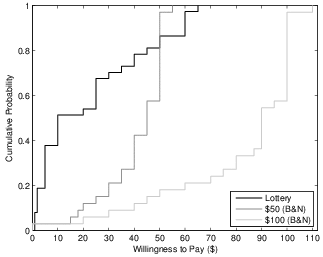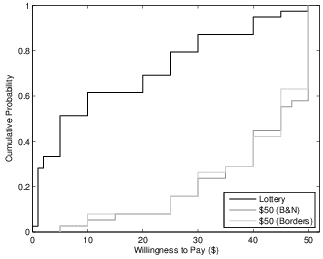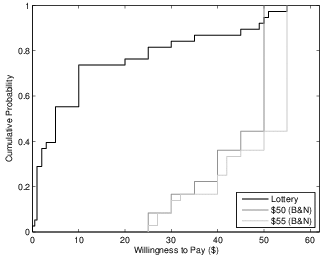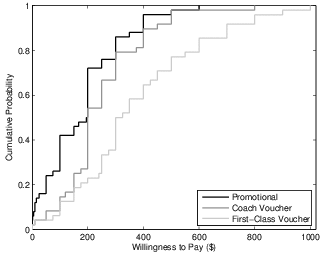| Figure 1: Experiment 1. The cumulative distributions of the willingness to pay for the lotteries and gift certificates in each condition. |



Judgment and Decision Making, vol. 7, no. 1, January 2012, pp. 19-24
Why are lotteries valued less? Multiple tests of a direct risk-aversion mechanismGeorge E. Newman* Daniel Mochon# |
Recent studies have identified the uncertainty effect (UE), whereby risky prospects (e.g., a binary lottery that offers either a $50 or $100 gift certificate) are valued less than their worst possible outcome (a $50 certificate). This effect has been proposed to result from “direct risk-aversion” which posits that the mere uncertainty of a lottery directly decreases its value. However, this effect may also be driven by the potential disappointment inherent in not receiving the better of the two outcomes (disappointment aversion), or the mere fact that the risky prospect is referred to as a “lottery”. The results of two experiments do not support either of these two alternatives. Specifically, the results of Experiment 1 indicate that the UE is observed even when the values of the two lottery outcomes are similar, or even identical. Experiment 2 further replicates the UE in a context in which the word “lottery” is never used (a company promotional). These results are consistent with a direct risk-aversion mechanism (Gneezy et al., 2006; Simonsohn, 2009) and suggest that the UE obtains across a number of different contexts.
Keywords: uncertainty effect, risk aversion, lottery.
Recent studies have identified the following peculiar effect: Individuals are willing to pay significantly less for a binary lottery that offers either a $50 or $100 gift certificate with equal probability than they are for a $50 gift certificate alone (Gneezy, List, & Wu, 2006; Simonsohn, 2009). This uncertainty effect (UE) is not only counterintuitive, it also presents an important challenge to current theories of risk-aversion, which arrive at risk-aversion indirectly (through the shape of the utility function) and predict that risky prospects should be valued no lower than the value of their worst possible outcome (for reviews, see Machina, 1987; Starmer, 2000; Wu, Zhang & Gonzales, 2004). Indeed, although the disutility of gambling has been alluded to in the literature, it has generally been avoided in formal models because it implies unpalatable patterns such as the violation of internality (Diecidue, Schmidt, & Wakker, 2004).
The first paper to demonstrate the UE (Gneezy, et al., 2006) did so across a number of different contexts (both hypothetical and real), suggesting that this effect does not arise from incidental features of a particular paradigm. Specifically, the UE was replicated for non-monetary outcomes (e.g., the number of minutes one is willing to work on a boring task), studies using choice rather than willingness to pay (WTP, e.g., $25 for sure vs. a 50:50 lottery offering either a $50 or $100 gift certificate), and in real world situations for actual goods. By ruling out a number of plausible alternative explanations, the authors interpret the UE as resulting from a “direct risk-aversion” mechanism, which posits that uncertainty per se directly decreases the utility of risky prospects. In other words, it is the mere uncertainty about which outcome one will receive that makes the lottery less valuable.
In support of the direct risk-aversion mechanism, Simonsohn (2009) built on the original finding of Gneezy et al. (2006) by ruling out two additional alternative explanations for the UE. First, Simonsohn (2009) found that the UE was observed even when participants in the certainty condition ($50 for sure) were aware of the better outcome ($100), which rules out the possibility that the mere awareness of the better outcome may devalue the worse one. Second, he demonstrated that the majority of participants understood the instructions and that the UE was not caused by the few who did not, which rules out the possibility that this effect is observed simply because participants misunderstand the task (see Keren & Willemsen, 2008; Rydval et al., 2009). On this basis, Simonsohn (2009) similarly concluded that aversion to uncertainty per se (i.e., direct risk-aversion) is likely responsible for the UE.
There are, however, at least two remaining alternative explanations for the UE, which have been unaddressed by previous research. The first involves “disappointment aversion”—that is, people may value lotteries less because of the potential disappointment inherent in not receiving the better of the two outcomes (Bell, 1985; Loomes & Sugden, 1986). For example, the $50 won in a lottery may seem worse than $50 guaranteed, because an individual knows they did not receive $100. Thus, the UE may result from the discrepancy in values between the better and worse outcomes, rather than from the uncertainty of the lottery itself.
This alternative explanation can be distinguished experimentally from a “direct risk-aversion” mechanism by manipulating the value of the better outcome. According to Bell’s (1985) and Loomes & Sugden’s (1986) models of disappointment, the amount of disappointment should be zero when both outcomes are equivalent, and increase monotonically in their difference. Consequently, if the UE is driven by the anticipated disappointment inherent in not receiving the better of the two outcomes (Mellers, 2000; Mellers & McGraw, 2001), this effect should be eliminated (or at least attenuated) when the lottery outcomes are equivalent in their perceived value (e.g., a lottery for one of two bookstore gift certificates, each worth $50). If, however, the UE arises solely from the mere uncertainty about which outcome one will receive, then the effect should persist despite the equivalent values. This alternative was examined in Experiment 1.
A second plausible explanation for the UE may be that participants are willing to pay less for the lottery because they just have a general aversion to the term “lottery”. This might be the case because some people consider such activities immoral and against their beliefs (e.g. Ellison & McFarland, 2011). Moreover, lotteries (such as the state lotto) are typically low-probability gambles with an expected value that is less than the price of entry into the lottery. As a result, participants may be suspicious of the term “lottery” because, in the real world, such offers typically signal prospects with negative expected value. To address this alternative, Experiment 2 presented participants with a company promotional that did not use the term “lottery” and thus was able to examine whether the UE persists in non-lottery contexts.
The goal of Experiment 1 was to test the alternative hypothesis that the UE results from the anticipated disappointment inherent in not receiving the better of the two lottery outcomes.
A sample of 221 adult participants were recruited through an online panel maintained by a northeastern U.S. university. At the time these studies were conducted, the panel consisted of approximately 3,900 active participants with a median age of 34, with slightly more women (68%) than men. The majority of the panel was Caucasian (75%), nearly all (93%) were native English speakers, and most (85%) had at least some college education. The median household income was between $50,000 and $74,999.
Participants answered hypothetical WTP questions. The experiment had a 3 (item-type) X 2 (certain vs. uncertain outcome) between-participants design, in which three conditions, each presenting a different pair of low- and high-value items, were crossed with whether participants indicated their WTP for each of the two items (certainty condition) or for a corresponding 50:50 lottery (uncertainty condition). Each participant evaluated only one item pair or lottery (depending on condition). The three item pairs included a replication condition that was identical to Simonsohn (2009) (a $50 gift certificate to Barnes and Noble and $100 gift certificate to Barnes and Noble), an equal value condition (a $50 gift certificate to Barnes and Noble and a $50 gift certificate to Borders), and a small difference condition (a $50 gift certificate to Barnes and Noble and $55 gift certificate to Barnes and Noble). The materials were taken verbatim from Simonsohn (2009) and the exact wording in the certain and uncertain outcome conditions was as follows (note that in the equal value conditions, the $50 gift certificate to Borders occupied the place of the “high-value item” even though both outcomes were equally valuable):
Certain outcomesWe are interested in how much you would be willing to pay for two different items. In particular we will ask you how much you would be willing to pay for [low-value item] and for [high-value item].
If you could only buy the [low-value item], what is the highest amount of money you would pay for it?____
If you could only buy the [high-value item], what is the highest amount of money you would pay for it?____
Uncertain outcomesWe are interested in how much you would be willing to pay for a lottery ticket that will for sure pay one of two possible rewards (both are equally likely). It will either pay [low-value item] or [high-value item].
What is the highest amount of money you would pay for this lottery?___
Table 1: Results from all experiments: Willingness to pay for binary lotteries and for their respective outcomes (between-subjects).
Observations (n) Note. Log t-tests correspond to t-tests performed on the log-transformed values of the WTP estimates.
As seen in Table 1, the UE (WTPlottery< WTPlow-value item) was observed in all three sets of conditions. Specifically, when the values of the gift certificates were $50 and $100 respectively, we replicated previous studies (Gneezy et al., 2006; Simonsohn, 2009) and observed that participants were willing to pay significantly less for the lottery (M=$22.59, SD=21.28) than they were for the $50 gift certificate (M=$40.55, SD=12.78), t(68)=4.21, p<.001.
Interestingly, the UE was also observed in the equal value and small difference conditions. In the equal value condition, participants were willing to pay significantly less for the lottery (M=$14.21, SD=14.91) than they were for either the $50 gift certificate to Barnes and Noble (M=$40.32, SD=12.22), t(75)=8.39, p< .001, or for the $50 gift certificate to Borders (M=$39.87, SD=12.44), t(75)=8.19, p< .001. Importantly, there was no difference in WTP between the two $50 gift certificates (and WTP for each one was significantly greater than the lottery), which indicates that these outcomes were equivalent in their perceived value. Similarly, in the small difference condition participants were willing to pay significantly less for the lottery (M=$13.25, SD=16.87) than for the $50 gift certificate to Barnes and Noble (M=$43.61, SD=8.67), t(72)=9.65, p<.001. All comparisons were significantly different using both parametric and non-parametric analyses (as seen in Table 1).
Figure 1: Experiment 1. The cumulative distributions of the willingness to pay for the lotteries and gift certificates in each condition.

The results from Experiment 1 are consistent with a direct risk-aversion mechanism. Most notably, the UE was observed even when the two outcomes of the lottery were equivalent in value and thus, the only potential cause of the UE was the uncertainty of the lottery itself. This result provides evidence against the anticipated disappointment alternative, which predicts that reducing or eliminating the discrepancy in value between the “better” and “worse” outcomes should attenuate the UE. It is important to note that this result obtained using a very conservative test of the hypothesis (comparing the means of the two groups). Even if there was no mean difference between the groups, there might still be a large percentage of people showing the uncertainty effect that would be obscured by another group of people willing to pay a lot for the gamble. Indeed, it sometimes necessary to look at the cumulative distributions to detect the such effects (see Simonsohn, 2009), though this was not the case in the present study. Figure 1 shows the cumulative distributions for the current study.
Interestingly, participants were willing to pay more for the lottery offering $50 and $100 gift certificates than for the lottery offering two $50 gift certificates. This suggests that people aren’t completely insensitive to the outcomes of the lottery—they are willing to pay more for better lotteries, but appear to place a penalty on them for their inherent uncertainty. It is also interesting that participants’ WTP for the $50 gift certificate was unaffected by whether they were also stating their WTP for another $50 gift certificate or a $100 one. This further weighs against the possibility that the uncertainty effect is driven by a contrast effect between the two outcomes (Simonsohn, 2009).
Experiment 1 replicated the UE both when the lottery outcomes were similar in value as well as when the outcomes were equivalent in perceived value, suggesting that the UE does not result from the anticipated disappointment inherent in potentially not receiving the better of the two outcomes. The peculiarity of these effects—for instance, that participants report that they are willing to pay less for a lottery that offers $50 regardless of outcome than they are for either of two certain outcomes also worth $50—suggests that there is something deeply inconsistent between people’s valuation of certain versus uncertain outcomes. Moreover, based on the results of Experiment 1 as well as previous ones, it does not appear to be the case that the UE arises because people misunderstand the task (see Simonsohn, 2009), because the WTP values are hypothetical (Gneezy et al., 2006), or because valuation was elicited in particular manner (Gneezy et al., 2006).
Given this “laundry list” of potential alternatives, which seem to have been ruled out empirically, perhaps it is the case that people simply don’t like lotteries. In other words, it may be that people have negative associations with the term “lottery” (for many of the reasons discussed in the Introduction) and thus, are willing to pay less for a lottery than for its worst possible outcome. To explore this possibility, Experiment 2 examined whether the UE persists in a context that does not use the term “lottery.” If the UE is in fact due to a simple reluctance to pay money for lotteries, then the UE should to be attenuated when the uncertain outcome is framed in an alternative manner.
Ninety-nine adult participants who did not participate in the previous study were recruited from the same online panel (one extreme outlier whose response was more than 5 S.D. from the mean was removed from the analyses). This experiment had two conditions. In one condition, participants reported how much they would be willing to pay for two certain outcomes, one voucher good for a round-trip coach ticket anywhere in the U.S. and one voucher good for a round-trip first-class ticket anywhere in the U.S. In a second condition, participants specified how much they would be willing to pay for a coach ticket that offered a 50% probably of being upgraded to a first-class ticket. Note that this framing not only avoids the term “lottery,” it also makes it highly salient that the default is the worst possible outcome (a coach ticket) and that the better outcome is an extra bonus on top of that default (an upgrade to first class). Finally, this scenario examined valuation in a context in which the retail value of the good was not specified (i.e., a round-trip voucher, rather than a $50 gift certificate). The exact wording of the materials was as follows:
Certain outcomesWe are interested in how much you would be willing to pay for two different items. In particular we will ask you how much you would be willing to pay for an airline voucher good for a round-trip coach ticket anywhere in the continental U.S. and how much you would be willing to pay for an airline voucher good for a round-trip first-class ticket anywhere in the continental U.S.
If you could only buy the coach airline voucher what is the highest amount of money you would pay for it?____
If you could only buy the first-class airline voucher what is the highest amount of money you would pay for it?____
Uncertain outcomesWe are interested in how much you would be willing to pay for an airline voucher good for a round-trip coach ticket anywhere in the continental U.S. The airline is currently running a promotional. Half of the customers who purchase this voucher will be randomly selected to be upgraded to a first-class seat. The other half of customers will remain in the coach section.
What is the highest amount of money you would pay for this voucher?___
Figure 2: Experiment 2. The cumulative distribution of the willingness to pay for a promotional (a coach voucher with a 50:50 likelihood of being upgraded to first-class), a coach voucher, and a first-class voucher on the same airline. 
Consistent with the results of the previous study, we observed the UE for valuation of a company promotional (see Figure 2 for the WTP distributions for each item). Specifically, participants were willing to pay significantly less for the coach ticket when it offered the uncertain possibility of being upgraded to first-class (M =$181.1, SD=139.62) than they were for the (certain) coach-ticket voucher (M=$248.56, SD = 146.78), t(96) = 2.33, p < .05. This difference was statistically significant via both parametric and non-parametric tests (see Table 1). The fact that the UE persists even in the case of the airline voucher, when it is clear that the lottery only adds value to the worst possible prospect, is surprising and consistent with a direct risk-aversion mechanism.
Taken together, the results of these two experiments indicate that the UE, the valuation of a risky prospect below its worse possible outcome, does not appear to result from either of two plausible alternative explanations, which have been unaddressed by previous research. Specifically, the UE is observed even when there is no difference in perceived value between the two outcomes, when there is a minimal difference in value between the two outcomes, when the term “lottery” is not used, and when it is highly salient to participants that the lottery offers a bonus on top of an existing default (the low-value outcome). These results are quite striking when considering, for example, that in the case of the equivalent outcomes, participants were willing to pay less for a lottery that offered $50 regardless of outcome (with the only unknown being a minimal difference in the book retailer) than they were for either of two certain outcomes also worth $50.
The present studies do not support either of the two alternatives mechanisms proposed in the Introduction and instead appear to be consistent with the notion that uncertainty per se directly decreases the utility of risky prospects (Gneezy et al., 2006; Simonsohn, 2009). Here, we find that the UE obtains across a wide range of values (i.e., $50 vs. 55 vs. $100) and contexts, though presumably there is some upper bound on this effect (e.g., a lottery offering a potential payment of $50 or $1,000,000). Indeed, the popularity of lotteries in the real world (e.g., the state lotto), suggests that at some point, the UE reverses such that a lottery becomes much more attractive than a “sure thing,” given its potential to pay out a large amount (Haisley, Mostafa, & Lowenstein, 2008). At the same time, there are many differences between the types of lotteries examined here and those found in the real world (e.g., differences in the cost of entry into the lottery). One potential avenue for future research may be to investigate such differences more systematically to clarify the conditions under which lotteries are more (less) attractive.
More generally, the nature of these effects, particularly those observed in Experiment 2, suggest that the UE does not appear to be due to incidental features of the task such as the categorization of the offer as a “lottery”. Rather, the UE seems to be rooted in a general aversion to uncertainty (Ellsberg, 1961). These results suggests a promising avenue for future work, which may begin to unpack the nature and degree to which people may hold explicit beliefs about uncertainty that give rise to this curious and seemingly inconsistent pattern of responding.
Bell, D. E. (1985). Disappointment in decision making under uncertainty. Operations Research, 33, 1–27.
Diecidue, E., Schmidt, U., & Wakker, P. P. (2004). The utility of gambling reconsidered. The Journal of Risk and Uncertainty, 29, 241–259.
Ellison, C. G., & McFarland, M. J. (2011). Religion and gambling among U.S. adults: Exploring the role of traditions, beliefs, practices, and networks. Journal for the Scientific Study of Religion, 50, 82–102.
Ellsberg, D. (1961). Risk, ambiguity, and the Savage axioms. The Quarterly Journal of Economics, 75, 643–669.
Gneezy, U., List, J. A., & Wu, G. (2006). The uncertainty effect: When a risky prospect is valued less than its worst outcome. Quarterly Journal of Economics, 121, 1283–1309.
Haisley, E., Mostafa, R., & Loewenstein, G. (2008). Subjective relative income and lottery ticket purchases. Journal of Behavioral Decision Making, 21, 283–295.
Keren, G., & Willemsen, M. C. (2008). Decision anomalies, experimenter assumptions, and participants’ comprehension: Reevaluating the uncertainty effect. Journal of Behavioral Decision Making, 22, 301–317.
Loomes, G., & Sugden, R. (1986). Disappointment and dynamic consistency in choice under uncertainty. The Review of Economic Studies, 53, 271–282.
Machina, M. J. (1987). Choice under uncertainty: Problems solved and unsolved. Journal of Economic Perspectives, 1, 121–154.
Mellers, B. A. (2000). Choice and the relative pleasure of consequences. Psychological Bulletin, 126, 910–924.
Mellers, B. A., & McGraw, P. (2001). Anticipated emotions as guides to choice. Current Directions in Psychological Science, 10, 210–214.
Rydval, O., Ortmann, A., Prokosheva, A., & Hertwig, R. (2009). How certain is the uncertainty effect? Experimental Economics, 12, 473–487.
Simonsohn, U. (2009). Direct Risk Aversion: Evidence From Risky Prospects Valued Below Their Worst Outcome, Psychological Science, 20, 691–692.
Starmer, C. (2000). Developments in non-expected utility-theory: The hunt for a descriptive theory of choice under risk, Journal of Economic Literature, 38, 332–382.
Wu, G., Zhang, J., & Gonzalez, R. (2004). Decision under risk. In D. J. Koehler & N. Harvey (Eds.), Blackwell Handbook of Judgment and Decision Making, 399–423. Oxford: Blackwell.
This document was translated from LATEX by HEVEA.